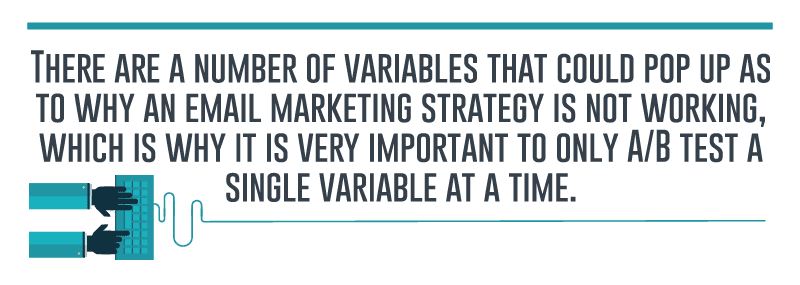
In today’s era of social network-driven advertising, search engine optimization, and what appears to be an overwhelmingly large emphasis on organic lead generation, you’d be forgiven for thinking that email marketing no longer packs the punch it did only a few years ago.
Interestingly, the raw data being collected by marketing firms today helps paint a vastly different picture of the potential of email marketing. According to recent statistics published in Entrepreneur, email marketing delivers arguably the highest return-on-investment (ROI) of any digital marketing service being used today.
This is not only due to the fact that small- to medium-sized businesses can often deploy large email marketing campaigns at very affordable prices, but also because email provides countless opportunities for personalization and automation that are simply unavailable in competing platforms.

In fact, a 2014 report by Gigaom Research has revealed that email marketing remains the most powerful and consistently effective method online marketing for developing and improving relationships with customers. Email marketing has been one of the most resilient email marketing strategies. Whether your business primarily uses search engine optimization or social media marketing, email marketing is always there to collect and nurture your email lists for whenever you need them.
For those of you who have already been involved in email marketing with mixed or disappointing results, perhaps the most obvious question becomes “Okay, so what am I doing wrong?”
While there may not be a single “one-stop” solution for reviving your email marketing efforts, you can quickly begin tweaking and refining your strategies by identifying any cracks or shortcomings in your own efforts. With that in mind, here are some of the most common reasons why email marketing campaigns fall flat.

Mistake #1: You Forgot About Formatting
While email marketing may have remained a relatively unchanged method of communication and engagement over the past decade, the platforms on which emails are received, read, and shared have changed dramatically.
With this in mind, it should come as no surprise that one of the most common mistakes made in during email marketing is failing to account for the specific technical challenges and opportunities offered by the various devices—whether those are tablets, laptops, or smartphones—being used today to view email content.
 According to a recent study by Emailmonday, well over half of all emails being opened today are read on smartphones and other portable devices. This statistic is shocking when it is compared to similar data collected less than five years ago, which confirmed the desktop and laptop computers’ domination of the email domain.
According to a recent study by Emailmonday, well over half of all emails being opened today are read on smartphones and other portable devices. This statistic is shocking when it is compared to similar data collected less than five years ago, which confirmed the desktop and laptop computers’ domination of the email domain.
Responsive design—the act of creating various formats of a particular piece of content for a particular device—is one method by which email marketers have attempted to navigate the migration of email from desktop to mobile. For the most part, responsive design has proven itself immensely successful. In fact, it would not be an exaggeration to say that almost all of the email marketing campaigns developed today that have yielded impressive ROI have adopted responsive design.
It’s easy to spot an email which has yet to be tweaked for mobile. Disproportionately large fonts, finicky links, and endless scrolling are three telltale signs that an email marketing team has not changed with the times. Unfortunately for them, creating such inconveniences for customers will almost certainly lead to decreased click-through and, consequently, reduced conversion.

Mistake #2: You Let Images Do the Talking for You
Marketers are quick to point out the increasing popularity and effectiveness of multimedia content (pictures, videos, etc.) as a means of boosting click-through and conversion. While this certainly is an argument that can be thoroughly justified with respect to websites, social media platforms, and digital advertising, it can become a lethal mistake for email marketers.
 The reason for this is as follows: Only a small fraction of email users—particularly, those checking their email on a mobile platform—have their devices figured in such a way as to automatically load images.
The reason for this is as follows: Only a small fraction of email users—particularly, those checking their email on a mobile platform—have their devices figured in such a way as to automatically load images.
More often than not, emails are predominantly text-based—when images are included, they function as a subsidiary complement to the text content rather than a core component of the message or the desired objective (i.e., a click-through, share, etc.).
All too often, marketers launch email campaigns with artfully designed messages, only to find that their click-through rates are lower than if they had stuck exclusively to generically-designed text messages.
It is also incredible to remember the role that page load time plays in determining bounce rate and user retention. According to Kissmetrics, 73% of mobile web users have reported abandoning a webpage or an email due to the fact that it failed to load within a reasonable time frame.
It would be a critical mistake to believe that audiences are willing to wait around for your content to reveal itself in their browser. In fact, the chances are good that your email will be closed and deleted within a matter of seconds if its load time is delayed.
With this in mind, it’s essential to prioritize efficiency and economy of content when designing email marketing campaigns. The message—whatever it may be—must be delivered almost instantaneously on page load in order to ensure that readers don’t fall victim to impatience or apathy.

Mistake #3: You Failed to Respect the Importance of the Subject Line
According to SalesForce, nearly 33% of email readers have opened an email sent to them for marketing purposes based upon the appeal of its subject line. From one angle, this statistic may seem surprising—after all, given the vast number of emails any one of us receives on a regular basis, why would we feel compelled to open an anonymous email, obviously sent to drive a product sale, simply because we liked the subject? And, yet, it is this very question which demonstrates the importance of this particular issue.
Regardless of how illogical or superficial it may seem, subject lines are the first impression we receive of an email and are, thus, the dominant influencer which may lead to it being opened and read.
![]() After working your way through the tangles of direct marketing copy, CTAs, and whatever else you may be throwing into your email, you’re probably dreaming of the opportunity to hit “send” and forget about it entirely. Without devoting the proper amount of attention to the subject line, however, you might as well just not send it. The rewards for a proper investment of time in a subject heading are compelling.
After working your way through the tangles of direct marketing copy, CTAs, and whatever else you may be throwing into your email, you’re probably dreaming of the opportunity to hit “send” and forget about it entirely. Without devoting the proper amount of attention to the subject line, however, you might as well just not send it. The rewards for a proper investment of time in a subject heading are compelling.
According to QuickSprout, your email subscribers are almost three times more likely to distribute and share information about your promotions, sales, and product launches with friends and family than those who first engage with your products on social media.
Similarly, studies have shown that over 40% email subscribers make a purchase each year based solely on the information they encounter within a promotional email. These users are not relying on social media to inform them, nor are they are part of the demographic that is “organic search traffic.”
Simply put, these customers are individuals who have previously connected with your business and are prepared to either initiate a first-time purchase or a repeat transaction, assuming you give them the opportunity to do so.

Mistake #4: You Arrived Unannounced
The idea of cold-emailing thousands of potential clients can be alluring, particularly if you’re seeking to establish traction in the earliest stages of your business. Whether you’ve decided to purchase an email list (a shady, yet common practice) or are attempting to scrape emails from newsletter mailing lists, forums, etc., it’s not too difficult to amass a hefty list of individuals you may consider to be potential customers.
That being said, the moment you begin sending out emails to “subscribers” who, in all reality, have never heard of your business or subscribed to your mailing list is the first moment you transition from a marketer into a spammer, a shift which can have serious legal and professional consequences. This is why it is imperative to have an active effort in building your email list so your subscribers are familiar with your brand. Set clear expectations of what subscribers can look forward to in emails and how often they will receive an email.
 The vast majority of Western nations have begun implementing anti-spam laws designed to protect consumers from unwanted emails littering their inbox. Much like legislation has been passed in previous years to ensure that individuals weren’t receiving generic sales calls at all hours of the day, attention has now been turned toward the digital domain and the protections which should be afforded to email users.
The vast majority of Western nations have begun implementing anti-spam laws designed to protect consumers from unwanted emails littering their inbox. Much like legislation has been passed in previous years to ensure that individuals weren’t receiving generic sales calls at all hours of the day, attention has now been turned toward the digital domain and the protections which should be afforded to email users.
Businesses who cull email addresses using indirect means such as purchasing lists can quickly be found in violation of laws such as the US CAN-SPAM law. Violating these laws can lead to very real penalties which extend well beyond irritated email users.
Likewise, those who launch spammy email campaigns will quickly gain a reputation as a non-reputable business. Social media has become a haven for both praise and criticism from customers toward business across a broad array of industries. Most likely, it is within this arena where your actions as a spammer will be reported, discussed, and shared with potential customers, inflicting untold damage to your brand going forward.
As a general rule of thumb, only email those individuals who have personally given you their email address. Whether it’s through a conversion form, a “Contact Us” page, or a promotional offer, there are numerous methods you can use to gain access to email contact information without resorting to unethical behavior. Not only will this help you keep your reputation as a professional above water, but it could also keep you out of legal trouble.

Final Thoughts
![]() Although we’ve discussed a variety of strategies for improving the overall effectiveness of your email marketing campaigns, it’s also important to determine what particular parameters should be a considered a gauge for measuring improvement.
Although we’ve discussed a variety of strategies for improving the overall effectiveness of your email marketing campaigns, it’s also important to determine what particular parameters should be a considered a gauge for measuring improvement.
Is an increase in the number of opens necessarily a sign that your content is doing its job? Likewise, is an absence of in-email clicks necessarily reflective of the quality of your subject line or the closeness of your connection with your subscribers?
It would be a mistake to evaluate your progress based solely on these numbers, particularly if you don’t have the appropriate context from which to evaluate them.
What exactly is the goal of your email marketing campaign? Sure, this is a fundamental question, but it directly shapes the type of metrics you will use to evaluate whether or not your objective has been met. If, for example, your goal is to educate and inform customers in a non-direct marketing fashion, click-throughs may be less important than, say, email opens.
Likewise, if your goal is simply to sell as many products as possible, your in-email conversion rate should be a point of intense focus. If, irrespective of your current objectives, your emails simply aren’t being opened, it’s time to take a critical look at your subject headings.

Knowing where to look is only the first step to improving a given process. There are a number of variables that could pop up as to why an email marketing strategy is not working, which is why it is very important to only A/B test a single variable at a time.
Using an email marketing service that allows you to take advantage of A/B testing with a proven process is an easier way to go about finding what specific tactic works best.
We hope this information will help you develop a more informed and tactical approach to your email campaigns in the future. Wherever you may be on the path toward launching your next email marketing campaign, the information provided above can help you ensure that your content is primed for optimal visibility and user engagement. Best of luck!

